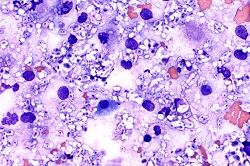Chest pain treatment offers hope for the fight against neglected fungal diseases
Fungal diseases represent an increasing danger to human health, especially for people with weakened immune systems as a result of the use of immunosuppressive drugs to treat a number of diseases, such as HIV. Research indicates that for the minority of fungal species that are human pathogens, their virulence seems to have evolved independently on multiple occasions. Better understanding of how this happens holds out the promise for more effective treatments. The MITOFUN project sought to identify possible treatments by starting with the hypothesis that a key switch for fungal virulence in animal hosts is to be found in fungal mitochondrion, an energy-producing organelle. Utilising the body’s own immune system MITOFUN used a combination of cell biology and genetic methodologies along with high-resolution imaging technology to study cryptococcus neoformans, a fungus responsible for lung infections and linked to fungal meningitis and encephalitis. Cryptococcus neoformans hides inside the patient’s own white blood cells making it especially hard to treat. At the University of Birmingham Drug Discovery facility in the UK, the MITOFUN team screened 1 200 FDA-approved off-patent drugs to find candidates that might alert white blood cells to their infection status and so trigger a fight response. After a secondary screening, 19 promising compounds listed in the Prestwick Chemical Library® of FDA-approved small molecules, were reduced to one strong anticryptococcal therapeutic candidate, fendiline hydrochloride. This compound is typically used in the treatment of angina and chest pain. It is thought that to stay alive, cryptococcus perturbs calcium signalling inside human cells; fendiline hydrochloride works by undoing this disruption, thus exposing the infection and so unleashing the defence response. Hope for a new treatment regime to tackle a neglected disease Immunocompromised patients are especially susceptible to Cryptococcosis neoformans infection and it is a leading cause of death for HIV/AIDS patients globally, with one million cases of cryptococcal meningitis estimated per year. In sub-Saharan Africa, with the highest occurrence of cryptococcal meningitis related deaths in HIV-positive patients, the mortality rate is 70 %. Infection usually begins with the inhalation of agents (spores or dessicated yeasts) which result in a pulmonary infection, which can then travel to the central nervous system causing meningitis. One of the reasons that Cryptococcosis is so hard to fight is that, compared to other infectious agents such as bacteria, its genome is much closer to that of humans. Therefore, targeting a pathway distinct to the fungus but not manifested in humans is a significant challenge, with treatments targeting the fungus also possibly being a risk for the overall health of the patient. MITOFUN’s findings, offering calcium-channel blockers such as fendiline hydrochloride as a strategy for possible anticryptococcal drug design and therapy, were published in the International Journal of Antimicrobial Agents. However, despite the promise of using fendiline hydrochloride to stimulate the body’s own immune system to fight infection, the relatively high doses required make it unfit as a stand-alone treatment. The findings do however open up fertile research avenues for further efforts to counter this neglected disease. For more information please see: CORDIS project page
Countries
United Kingdom



